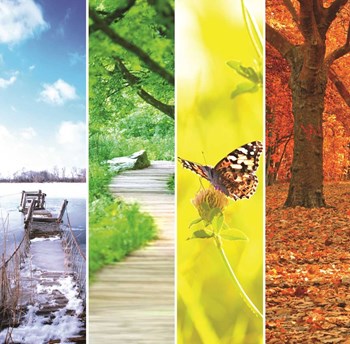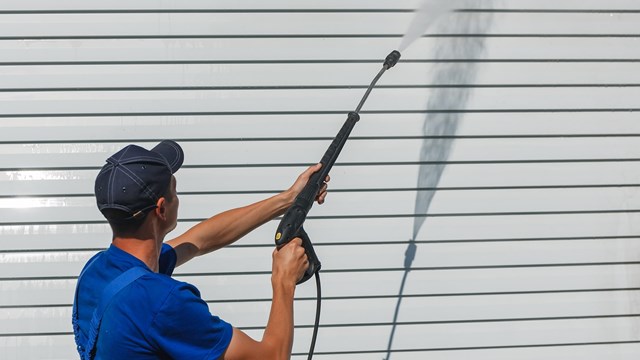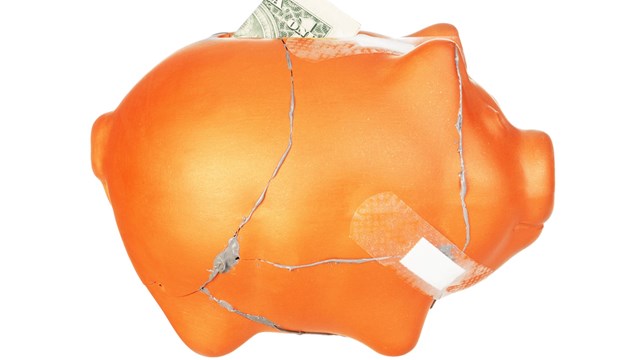
People aren’t the only life on your association's property; there are plants, trees, and other living landscaping elements as well. More than just decoration, these features provide the community a vitality and serene pleasure only nature can provide. And whether you're a sprawling suburban HOA or in the city proper with just a courtyard or tree well, the lawn, trees and flowers in your landscape need regular maintenance throughout the year in order to stay healthy and vibrant, with special treatment each season to suit the stages of their life cycles.
Spring Cleanup
Spring cleanup and prep set the stage for a resplendent summer. “Spring is a very busy time for the landscaper,” says Sherman Fields, vice president of Acres Group, a landscape maintenance company with three offices in the Chicagoland area. “In early spring, the board of directors and property management should inspect the landscape to take an inventory of what needs to be done—what didn’t make it over the winter and what needs to be removed and replaced.”
According to the professionals, the first order of business is clearing the lawn of any branches, leaves or trash that may have gathered over the winter, and dethatching— clearing out old, dead grass and organic buildup to make way for new seedlings to come out in the late spring and summer. Debris that accumulates over the winter can harbor insects, insect egg casings and fungus spores. Removing the debris reduces the probability of insect infestation or fungi. Also, dethatching the lawn allows water and nutrients from fertilizer to penetrate the surface.
Evergreens and weak-wooded trees are particularly susceptible to snow damage. Unable to draw moisture from the frozen ground, their leaves or needles turn brown. If the winter burn damage is minimal, Fields says the brown tips of evergreens can be snipped off. If the browning is more extensive the shrubs might need to be replaced.
If you have roses, mid-March to April is the time to start cutting them back, almost in half, so they will bloom with all new growth.
Cultivating the Soil
After the winter thaw, says Carlos Medina of Chicago-based Medina & Sons Landscaping, “You should turn your soil over underneath your bedding area—cultivate the soil—because during the winter it becomes hard and compressed. You break up the soil to allow the water and air to get into the roots of your shrubs and plants.”
Medina recommends adding two to three inches of mulch to the soil. “It does two things,” he explains. “First, it releases vitamins and minerals in the mulch into the earth throughout the season, serving as a food for your roots.” Also, mulch is a weed barrier, keeping the sunlight from hitting the dirt and encouraging weed growth.
Plus, adds Medina, “It’s very attractive to see the contrast between the plants and the grass separated by a layer of mulch, as opposed to just bare dirt.”
Nip’em in the Bud
Early spring is the time to stop weeds from sprouting before the temperature reaches and stays at 55 degrees for several consecutive days, at which time crabgrass germination occurs. The pros recommend that a pre-emergent herbicide weed killer be applied before they emerge from the soil.
After thoroughly weeding the lawn and plant beds, apply a pre-emergent fertilizer to boost the nitrogen for the roots of the grass and nourish pre-emergent seeds. According to experts, in spring, your daffodils and tulips are blooming, and to ensure they continue for next year, put down fertilizer and spray them with deer spray, or 'bunny-scram' anti-rabbit repellent.”
One common mistake is fertilizing too early. Experts testify that if it is too cold, nothing will adhere and it is just a waste of money. Wait until the last frost-free day—around Mother’s Day—to plant those flowers.
Some plants might look like they’ve been beaten to death by winter but actually might just need some time to rejuvenate. Scrape the side of the plant with your fingernail to see if there is any green underneath. It might just need a little more time to come to life.
Summer Comes Alive
And so do bugs. In this part of the country, the greatest insect emergence occurs in mid-May to June. To eradicate summer pests like grub worms and beetles that feed on the tender root systems in the lawn, have your landscaper apply insecticide (but only if they have a license to do so, which is required in Illinois for certain pesticides), or call in a specialist who does.
One natural solution is what's called a “beneficial release.” This involves taking a species of insect that's antagonistic to pests and releasing them into your garden or grounds to wage war on your behalf. Cretaceous insects like ladybugs will take care of half the insect problems you find on certain trees and shrubs, and the pros say that the ladybug treatment doesn't cost any more than spraying pesticides. Milky spore is an environmentally-friendly way to control some species of grubs.
Another unwelcome summer growth is weeds. “Weeds grow better than anything,” says George Smith of Western DuPage Landscaping, Inc. in Naperville. “They can overrun the lawn, take away from the attractiveness of the landscape bed.”
To get rid of weeds, Medina recommends a product called Momentum, which will kill weeds like dandelion, crabgrass and Creeping Charlie, while leaving single-leaf plants like grass alone. “It’s amazing how they've come up with a chemical that attacks those plants, yet not the grass,” says Medina. But, he cautions, “You have to make sure it's properly diluted, and doesn’t accidentally drift onto your roses, shrubs or any kind of perennials or annuals on a windy day.”
Plants want to produce in summer and they need plenty of water to stay healthy and vigorous. But it’s equally important to avoid over-watering, according to the experts in the landscaping industry.
Down and Dirty
How do you tell if you’re providing enough water and not too much? Experts say that you have to get dirty...take your gloves off and put your fingers in the ground. There should be three inches of moist—but not soaking—soil.
While you’re on the ground, weed and deadhead (that's removing faded or dead flowers) to keep plants growing strong. And be sure to water your annuals in containers and add fertilizer at least twice a month to prevent the nutrients from washing away. Add Miracle-Gro to plants that aren’t doing well.
Also in summer, Smith advises mowing the lawn regularly, removing only one-third of the grass height with each round. Raise the mower height as the heat rises, as taller grass holds up to heat and drought better. Remove large clumps of clippings and regularly rake up any leaves, twigs and debris.
Contrary to popular belief, “Summer is a good time for planting,” says Smith. Early summer, that is. “I never, ever advise to plant during July or August.”
In late June, you can add additional annuals that usually burn out by late summer, like marigolds, sunflowers, zinnias, four o’clocks and nasturtiums, so you can enjoy a second flush of bloom through Labor Day. June and July are also good times to start seeds for perennials and biennials to bloom the following spring.
Fall Forward
“Fall is preparation for the winter,” says Smith,
Mostly, it’s about leaf removal. Too thick a covering will smother the lawn, encouraging fungus. But you can leave a light covering on the turf and plant beds, which will slowly break down and act as a natural mulch through winter.
Fall is the time to repair damaged and compacted areas of the lawn, by turning over the mulch and aerating the soil—pulling one-inch plugs of earth from the ground to release soil compaction, allowing the water and nutrients to get down to the root zone. “It should be done every single year,” advises Smith, “and twice a year if you have high traffic through certain areas of the lawn.”
It’s important to do a last round of fertilizer towards the end of fall. “We highly recommend a fall fertilization, which can be done up until Thanksgiving weekend,” says Fields. “You want to have the roots of the plants store as much energy as possible. It not only strengthens the plants but has the turf grass come out in better condition in the spring.”
Pruning schedules vary with different species of trees. For best results speak to an arborist to find out which trees need to be pruned and when, although it’s reasonably safe to maintain a semi-annual regimen, pruning late fall/early winter and mid-to-late spring.
Other than pruning, trees don’t require much maintenance in the fall, though it’s important to put one-to-three inches of mulch under trees as winter approaches. Dry mulch has the advantage of not needing water. In early fall, stop watering trees until their leaves fall. Then water them before the ground freezes so they have enough to moisture to survive the winter.
Fall is a good time to plant trees. Cooler temperatures put less stress on trees, allowing roots to get established. They also happen to be cheaper to buy after the growing season has ended.
Winter is Coming...
The two elements that most threaten the landscape in winter are snow and wind.
Just before the winter, “One of the most important things to do right out of the gate is to go over some specifications of snow removal with the snow contractor,” advises Fields, “so that you are on the same page and you understand expectations.”
The board and manager should sit down with the snow removal contractor to address such questions as who to contact if there is an ice storm and how to assist special needs people in a blizzard.
When treating snowfall during the winter, be mindful of where you put down your salts. Salting heavily on walkways can damage plants. Stay two to three feet away from shrub lines and foundation planting. Shrubs are extremely vulnerable in the snow. Most are under four feet high, making it difficult to rid them of snowpack without breaking them. One solution is to wrap the shrubs in burlap—an expensive project but in the long run preferable to replacing them.
Make the Cut
With trees, the most damaging element is wind. To mitigate the damage, you want to cut down any overextended, large, long limbs.
With trees and shrubs having shed their leaves, you can determine which areas to trim, experts say. Winter going into spring is the time to make harsher cuts in trees and foliage. It’s also the time to start dormant pruning, shortening and reshaping overgrown shrubs. Medina recommends treating the turf with a slow release fertilizer to feed the grass through winter, and to put manure or peat moss around plants to contain heat. Plus, he says, “you can aerate the lawn — punch holes in the ground to allow water and air to penetrate the grass throughout the winter.”
Oh, Deer
In areas outside the city, plants are vulnerable to damage from grazing deer. On a warmer day, they will come around and start munching on arborvitaes and rhododendrons in the late winter/early spring. Experts recommend using deer repellent through the season.
The rewards to the community of a verdant and beautiful landscape are priceless. At the same time, probably more than any amenity, an impressive landscape adds value to the property. Keeping the lawn and plantings healthy through diligent maintenance through the seasons will make sure its bounty, and the property’s value, thrive endlessly.
Steve Cutler is a freelance writer and a frequent contributor to The Chicagoland Cooperator.






Leave a Comment